Novel Liposomal Formulation with Azelaic Acid: Preparation, Characterization, and Evaluation of Biological Properties
Abstract
1. Introduction
2. Materials and Methods
2.1. Preparation of Liposomal Formulation
2.2. Physico-Chemical and Morphological Characterization
2.3. Encapsulation Efficiency Determined by Electrochemical Assay
2.4. Antimicrobial Activity against Gram (+) and Gram (−) Strains
2.5. Cell Viability
2.6. Cytotoxicity Assays (MTS Assay)
2.7. Assessing the Healing Effect of AALipo Using the “Scratch” Method
2.8. Comet Assay
- (a)
- Cells treatment. The fibroblasts were incubated with 75 µM H2O2 for 10 min to induce DNA damage, then a part of cells was washed with HEPES preheated to 37 °C and treated with 10% azelaic acid, and the cells were maintained in incubator (5% CO2, 37 °C) for 60 min (H2O2 + AZE sample). Other parts of cells after treatment with 75 µM H2O2 were used immediately for comet assay and represents the positive control (CTRL +). The negative control (CTRL −) consists of the cells treated with PBS (solvent where azelaic acid was dissolved).
- (b)
- Comet assay (neutral single cell gel electrophoresis) was performed according to Purcarea et al. [34]. Briefly, the fibroblasts (1.5–2 ×·105 cells) were embedded into 0.7% low-melting-point agarose gel (Thermo Scientific, Waltham, MA, USA) and deposited on microscopic glass slide pre-covered with 1% normal-melting-point agarose, covered with other glass slide and left for 5 min on ice. Then, the slides were immersed in lysis buffer (2.5 M NaCl, 100 mM EDTA, 10 mM Tris-HCl, 1% N-lauroilsarcozine, pH 9.5) with freshly added 0.5% Triton X-100 and 10% DMSO (dimethyl sulfoxide) for 1 h at 4 °C. Subsequently, the slides were washed three times for 5 min/time with electrophoresis buffer (300 mM sodium acetate, 100 mM Tris-HCl, pH 8.3) and then subjected to horizontal electrophoresis (14 V, 0.5 V/cm, 11–12 mA) for 1 h, in the dark at 4 °C. The slides were then washed three times with cold distilled water (neutralization step) and stained with 2 mg/mL ethidium bromide. Cells were visualized using Bio Systems fluorescent microscope equipped with a 546 nm excitation filter and a 590 nm emission filter and images were photographed and processed with Comet Score software (Comet Score 2.0.0.38; TriTek Corp., Sumerdock, VA, USA).
2.9. Statistical Analysis
3. Results and Discussions
3.1. Physico-Chemical and Morphological Characterization
3.2. Microscopic Characterization
3.3. DLS (Dynamic Light Scattering) and Zeta-Potential Measurements
3.4. Encapsulation Efficiency Determined by Electrochemical Assay
3.5. Antimicrobial Activity against Gram (+) and Gram (−) Strains
3.6. Cell Viability and Cytotoxicity (MTS Assay) of Normal Human Dermal Fibroblast Culture under Different Treatments with Liposomal Formulations
3.7. Assessing the Healing Effect of AALipo by “Scratch” Method
3.8. Comet Assay
4. Conclusions
Supplementary Materials
Author Contributions
Funding
Institutional Review Board Statement
Informed Consent Statement
Data Availability Statement
Acknowledgments
Conflicts of Interest
References
- Gollnick, H. A New Therapeutic Agent: Azelaic Acid in Acne Treatment. J. Dermatol. Treat. 1990, 1, S23–S28. [Google Scholar] [CrossRef]
- Pérez-Bernal, A.; Muñoz-Pérez, M.A.; Camacho, F. Management of Facial Hyperpigmentation. Am. J. Clin. Dermatol. 2000, 1, 261–268. [Google Scholar] [CrossRef] [PubMed]
- Vashi, N.A.; Kundu, R.V. Facial Hyperpigmentation: Causes and Treatment. Br. J. Dermatol. 2013, 169 (Suppl. S3), 41–56. [Google Scholar] [CrossRef] [PubMed]
- Rendon, M.; Berneburg, M.; Arellano, I.; Picardo, M. Treatment of Melasma. J. Am. Acad. Dermatol. 2006, 54, S272–S281. [Google Scholar] [CrossRef] [PubMed]
- Holland, K.; Bojar, R. Antimicrobial Effects of Azelaic Acid. J. Dermatol. Treat. 1993, 4, S8–S11. [Google Scholar] [CrossRef]
- Kumar, A.; Rao, R.; Yadav, P. Azelaic Acid: A Promising Agent for Dermatological Applications. Curr. Drug Ther. 2020, 15, 181–193. [Google Scholar]
- Sieber, M.A.; Hegel, J.K.E. Azelaic Acid: Properties and Mode of Action. Ski. Pharmacol. Physiol. 2014, 27 (Suppl. S1), 9–17. [Google Scholar] [CrossRef]
- Williams, H.C.; Dellavalle, R.P.; Garner, S. Acne Vulgaris. Lancet 2012, 379, 361–372. [Google Scholar] [CrossRef]
- Dréno, B. What Is New in the Pathophysiology of Acne, an Overview. J. Eur. Acad. Dermatol. Venereol. 2017, 31 (Suppl. S5), 8–12. [Google Scholar] [CrossRef]
- Otlewska, A.; Baran, W.; Batycka-Baran, A. Adverse Events Related to Topical Drug Treatments for Acne Vulgaris. Expert Opin. Drug Saf. 2020, 19, 513–521. [Google Scholar] [CrossRef]
- Thiboutot, D.M.; Weiss, J.; Bucko, A.; Eichenfield, L.; Jones, T.; Clark, S.; Liu, Y.; Graeber, M.; Kang, S. Adapalene-BPO Study Group Adapalene-Benzoyl Peroxide, a Fixed-Dose Combination for the Treatment of Acne Vulgaris: Results of a Multicenter, Randomized Double-Blind, Controlled Study. J. Am. Acad. Dermatol. 2007, 57, 791–799. [Google Scholar] [CrossRef] [PubMed]
- Rosen, T. Antibiotic Resistance: An Editorial Review with Recommendations. J. Drugs Dermatol. 2011, 10, 724–733. [Google Scholar]
- Thompson, K.G.; Rainer, B.M.; Antonescu, C.; Florea, L.; Mongodin, E.F.; Kang, S.; Chien, A.L. Minocycline and Its Impact on Microbial Dysbiosis in the Skin and Gastrointestinal Tract of Acne Patients. Ann. Dermatol. 2020, 32, 21–30. [Google Scholar] [CrossRef] [PubMed]
- Tomić, I.; Juretić, M.; Jug, M.; Pepić, I.; Cetina Čižmek, B.; Filipović-Grčić, J. Preparation of in Situ Hydrogels Loaded with Azelaic Acid Nanocrystals and Their Dermal Application Performance Study. Int. J. Pharm. 2019, 563, 249–258. [Google Scholar] [CrossRef] [PubMed]
- Kosmadaki, M.; Katsambas, A. Topical Treatments for Acne. Clin. Dermatol. 2017, 35, 173–178. [Google Scholar] [CrossRef]
- Patel, R.; Prabhu, P. Nanocarriers as Versatile Delivery Systems for Effective Management of Acne. Int. J. Pharm. 2020, 579, 119140. [Google Scholar] [CrossRef]
- Mancuso, A.; Cristiano, M.C.; Fresta, M.; Paolino, D. The Challenge of Nanovesicles for Selective Topical Delivery for Acne Treatment: Enhancing Absorption Whilst Avoiding Toxicity. Int. J. Nanomed. 2020, 15, 9197–9210. [Google Scholar] [CrossRef]
- Reis, C.P.; Gomes, A.; Rijo, P.; Candeias, S.; Pinto, P.; Baptista, M.; Martinho, N.; Ascensão, L. Development and Evaluation of a Novel Topical Treatment for Acne with Azelaic Acid-Loaded Nanoparticles. Microsc. Microanal. 2013, 19, 1141–1150. [Google Scholar] [CrossRef]
- Apriani, E.F.; Rosana, Y.; Iskandarsyah, I. Formulation, Characterization, and in Vitro Testing of Azelaic Acid Ethosome-Based Cream against Propionibacterium Acnes for the Treatment of Acne. J. Adv. Pharm. Technol. Res. 2019, 10, 75–80. [Google Scholar] [CrossRef]
- Kumar, A.; Rao, R. Enhancing Efficacy and Safety of Azelaic Acid via Encapsulation in Cyclodextrin Nanosponges: Development, Characterization and Evaluation. Polym. Bull. 2021, 78, 1–28. [Google Scholar] [CrossRef]
- Cavalu, S.; Simon, V.; Goller, G.; Akin, I. Bioactivity and antimicrobial properties of PMMAAg2O acrylic bone cement collagen coated. Dig. J. Nanomater. Biostructures 2011, 6, 779–790. [Google Scholar]
- Briuglia, M.-L.; Rotella, C.; McFarlane, A.; Lamprou, D.A. Influence of Cholesterol on Liposome Stability and on in Vitro Drug Release. Drug Deliv. Transl. Res. 2015, 5, 231–242. [Google Scholar] [CrossRef] [PubMed]
- Mohammadabadi, M.R.; Mozafari, M.R. Enhanced Efficacy and Bioavailability of Thymoquinone Using Nanoliposomal Dosage Form. J. Drug Deliv. Sci. Technol. 2018, 47, 445–453. [Google Scholar] [CrossRef]
- Miere (Groza), F.; Vicas, S.I.; Timar, A.V.; Ganea, M.; Zdrinca, M.; Cavalu, S.; Fritea, L.; Vicas, L.; Muresan, M.; Pallag, A.; et al. Preparation and Characterization of Two Different Liposomal Formulations with Bioactive Natural Extract for Multiple Applications. Processes 2021, 9, 432. [Google Scholar] [CrossRef]
- Luminita, F.; Cavalu, S.; Miere, F.; Vicaş, S. Formulation, Characterization, and Advantages of Using Liposomes in Multiple Therapies. Pharmacophore 2020, 11, 1–12. [Google Scholar]
- Miere, F.; Teuşdea, A.; Vasile, L.; Cavalu, S.; Luminita, F.; Dobjanschi, L.; Zdrânca, M.; Zdrânca, M.; Ganea, M.; Priscilla, P.; et al. Evaluation of In Vitro Wound-Healing Potential, Antioxidant Capacity, and Antimicrobial Activity of Stellaria Media (L.) Vill. Appl. Sci. 2021, 11, 11526. [Google Scholar] [CrossRef]
- Gopi, S.; Balakrishnan, P. Evaluation and Clinical Comparison Studies on Liposomal and Non-Liposomal Ascorbic Acid (Vitamin C) and Their Enhanced Bioavailability. J. Liposome Res. 2021, 31, 356–364. [Google Scholar] [CrossRef]
- Gibis, M.; Ruedt, C.; Weiss, J. In Vitro Release of Grape-Seed Polyphenols Encapsulated from Uncoated and Chitosan-Coated Liposomes. Food Res. Int. 2016, 88, 105–113. [Google Scholar] [CrossRef]
- Tucaliuc, D.; Alexa, O.; Tuchiluş, C.G.; Ursu, R.G.; Tucaliuc, E.S.; Iancu, L.S. Analysis of Antibiotic Resistance Pattern of S. Aureus Strains Isolated from the Orthopedics-Traumatology Section of “Sf. Spiridon” Clinical Emergency Hospital, Iaşi. Rev. Med. Chir. Soc. Med. Nat. Iasi 2014, 118, 780–787. [Google Scholar]
- Mintas, I.; Antonescu, A.; Miere, F.; Luminita, F.; Teuşdea, A.; Vicas, L.; Vicaş, S.; Ilarie, B.; Domuța, M.; Zdrîncă, M.; et al. Evaluation of Wound Healing Potential of Novel Hydrogel Based on Ocimum Basilicum and Trifolium Pratense Extracts. Processes 2021, 9, 2096. [Google Scholar] [CrossRef]
- Malich, G.; Markovic, B.; Winder, C. The Sensitivity and Specificity of the MTS Tetrazolium Assay for Detecting the in Vitro Cytotoxicity of 20 Chemicals Using Human Cell Lines. Toxicology 1997, 124, 179–192. [Google Scholar] [CrossRef] [PubMed]
- Kabakov, A.E.; Kudryavtsev, V.A.; Gabai, V.L. Determination of Cell Survival or Death. Methods Mol. Biol. 2011, 787, 231–244. [Google Scholar] [CrossRef] [PubMed]
- Sharma, P.; Lam, V.K.; Raub, C.B.; Chung, B.M. Tracking Single Cells Motility on Different Substrates. Methods Protoc. 2020, 3, E56. [Google Scholar] [CrossRef] [PubMed]
- Purcarea, C.; Laslo, V.; Memete, A.R.; Agud, E.; Miere (Groza), F.; Vicas, S.I. Antigenotoxic and Antimutagenic Potentials of Proline in Allium Cepa Exposed to the Toxicity of Cadmium. Agriculture 2022, 12, 1568. [Google Scholar] [CrossRef]
- Hsieh, P.-W.; Al-Suwayeh, S.A.; Fang, C.-L.; Lin, C.-F.; Chen, C.-C.; Fang, J.-Y. The Co-Drug of Conjugated Hydroquinone and Azelaic Acid to Enhance Topical Skin Targeting and Decrease Penetration through the Skin. Eur. J. Pharm. Biopharm. 2012, 81, 369–378. [Google Scholar] [CrossRef]
- Whittinghill, J.; Proctor, A. Determination of Phospholipids in Vegetable Oil by Fourier Transform Infrared Spectroscopy. J. Am. Oil Chem. Soc. 1998, 75, 1281–1289. [Google Scholar] [CrossRef]
- Pan, L.; Zhang, S.; Gu, K.; Zhang, N. Preparation of Astaxanthin-Loaded Liposomes: Characterization, Storage Stability and Antioxidant Activity. CyTA-J. Food 2018, 16, 607–618. [Google Scholar] [CrossRef]
- Wu, B.-Q.; He, Y.-J.; Yin, Z.-N.; Zhang, Z.-R.; Deng, L. Preparation and Characterization of Clopidogrel Bisulfate Liposomes. Sichuan Da Xue Xue Bao Yi Xue Ban 2021, 52, 630–636. [Google Scholar] [CrossRef]
- Yu, J.Y.; Chuesiang, P.; Shin, G.H.; Park, H.J. Post-Processing Techniques for the Improvement of Liposome Stability. Pharmaceutics 2021, 13, 1023. [Google Scholar] [CrossRef]
- Byrd, A.L.; Belkaid, Y.; Segre, J.A. The Human Skin Microbiome. Nat. Rev. Microbiol. 2018, 16, 143–155. [Google Scholar] [CrossRef]
- SanMiguel, A.J.; Meisel, J.S.; Horwinski, J.; Zheng, Q.; Grice, E.A. Topical Antimicrobial Treatments Can Elicit Shifts to Resident Skin Bacterial Communities and Reduce Colonization by Staphylococcus Aureus Competitors. Antimicrob. Agents Chemother. 2017, 61, e00774-17. [Google Scholar] [CrossRef] [PubMed]
- Boldock, E.; Surewaard, B.G.J.; Shamarina, D.; Na, M.; Fei, Y.; Ali, A.; Williams, A.; Pollitt, E.J.G.; Szkuta, P.; Morris, P.; et al. Human Skin Commensals Augment Staphylococcus Aureus Pathogenesis. Nat. Microbiol. 2018, 3, 881–890. [Google Scholar] [CrossRef] [PubMed]
- Nazzaro-Porro, M.; Passi, S.; Picardo, M.; Breathnach, A.; Clayton, R.; Zina, G. Beneficial Effect of 15% Azelaic Acid Cream on Acne Vulgaris. Br. J. Dermatol. 1983, 109, 45–48. [Google Scholar] [CrossRef] [PubMed]
- Bladon, P.T.; Burke, B.M.; Cunliffe, W.J.; Forster, R.A.; Holland, K.T.; King, K. Topical Azelaic Acid and the Treatment of Acne: A Clinical and Laboratory Comparison with Oral Tetracycline. Br. J. Dermatol. 1986, 114, 493–499. [Google Scholar] [CrossRef]
- Gollnick, H.P.; Bettoli, V.; Lambert, J.; Araviiskaia, E.; Binic, I.; Dessinioti, C.; Galadari, I.; Ganceviciene, R.; Ilter, N.; Kaegi, M.; et al. A Consensus-Based Practical and Daily Guide for the Treatment of Acne Patients. J. Eur. Acad. Dermatol. Venereol. 2016, 30, 1480–1490. [Google Scholar] [CrossRef]
- Hall, J.B.; Cong, Z.; Imamura-Kawasawa, Y.; Kidd, B.A.; Dudley, J.T.; Thiboutot, D.M.; Nelson, A.M. Isolation and Identification of the Follicular Microbiome: Implications for Acne Research. J. Invest. Dermatol. 2018, 138, 2033–2040. [Google Scholar] [CrossRef]
- Megyeri, K.; Orosz, L.; Bolla, S.; Erdei, L.; Rázga, Z.; Seprényi, G.; Urbán, E.; Szabó, K.; Kemény, L. Propionibacterium Acnes Induces Autophagy in Keratinocytes: Involvement of Multiple Mechanisms. J. Invest. Dermatol. 2018, 138, 750–759. [Google Scholar] [CrossRef]
- Burchacka, E.; Potaczek, P.; Paduszyński, P.; Karłowicz-Bodalska, K.; Han, T.; Han, S. New Effective Azelaic Acid Liposomal Gel Formulation of Enhanced Pharmaceutical Bioavailability. Biomed. Pharm. 2016, 83, 771–775. [Google Scholar] [CrossRef]
- Lacatusu, I.; Istrati, D.; Bordei, N.; Popescu, M.; Seciu, A.M.; Panteli, L.M.; Badea, N. Synergism of Plant Extract and Vegetable Oils-Based Lipid Nanocarriers: Emerging Trends in Development of Advanced Cosmetic Prototype Products. Mater. Sci. Eng. C Mater. Biol. Appl. 2020, 108, 110412. [Google Scholar] [CrossRef]
- Hajiaghaalipour, F.; Kanthimathi, M.S.; Sanusi, J.; Rajarajeswaran, J. White Tea (Camellia Sinensis) Inhibits Proliferation of the Colon Cancer Cell Line, HT-29, Activates Caspases and Protects DNA of Normal Cells against Oxidative Damage. Food Chem. 2014, 169, 401–410. [Google Scholar] [CrossRef]
- Cavalu, S.; Damian, G.; Dansoreanu, M. EPR study of non-covalent spin labeled serum albumin and hemoglobin. Biophys. Chem. 2002, 99, 181–188. [Google Scholar] [CrossRef] [PubMed]
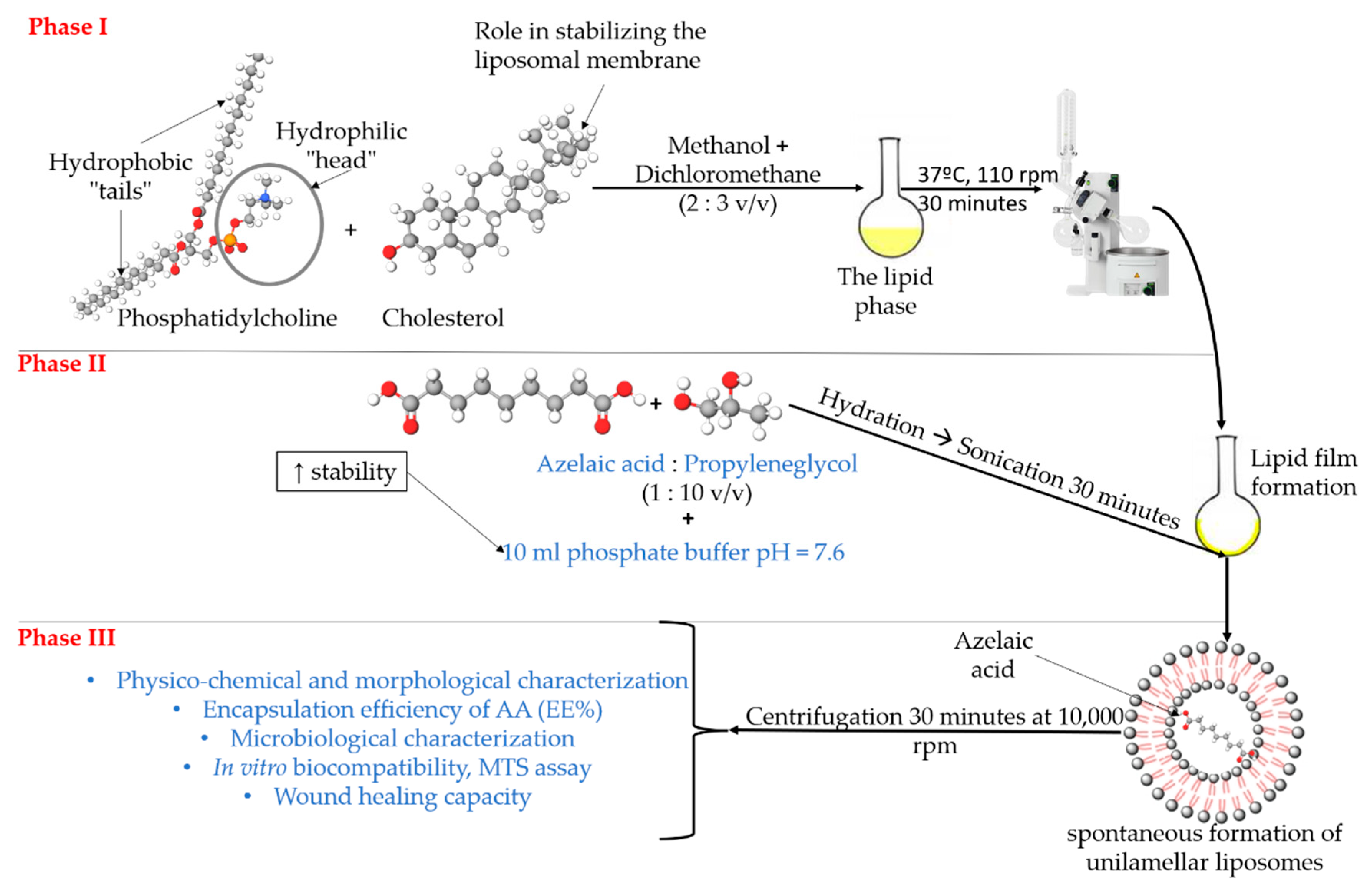

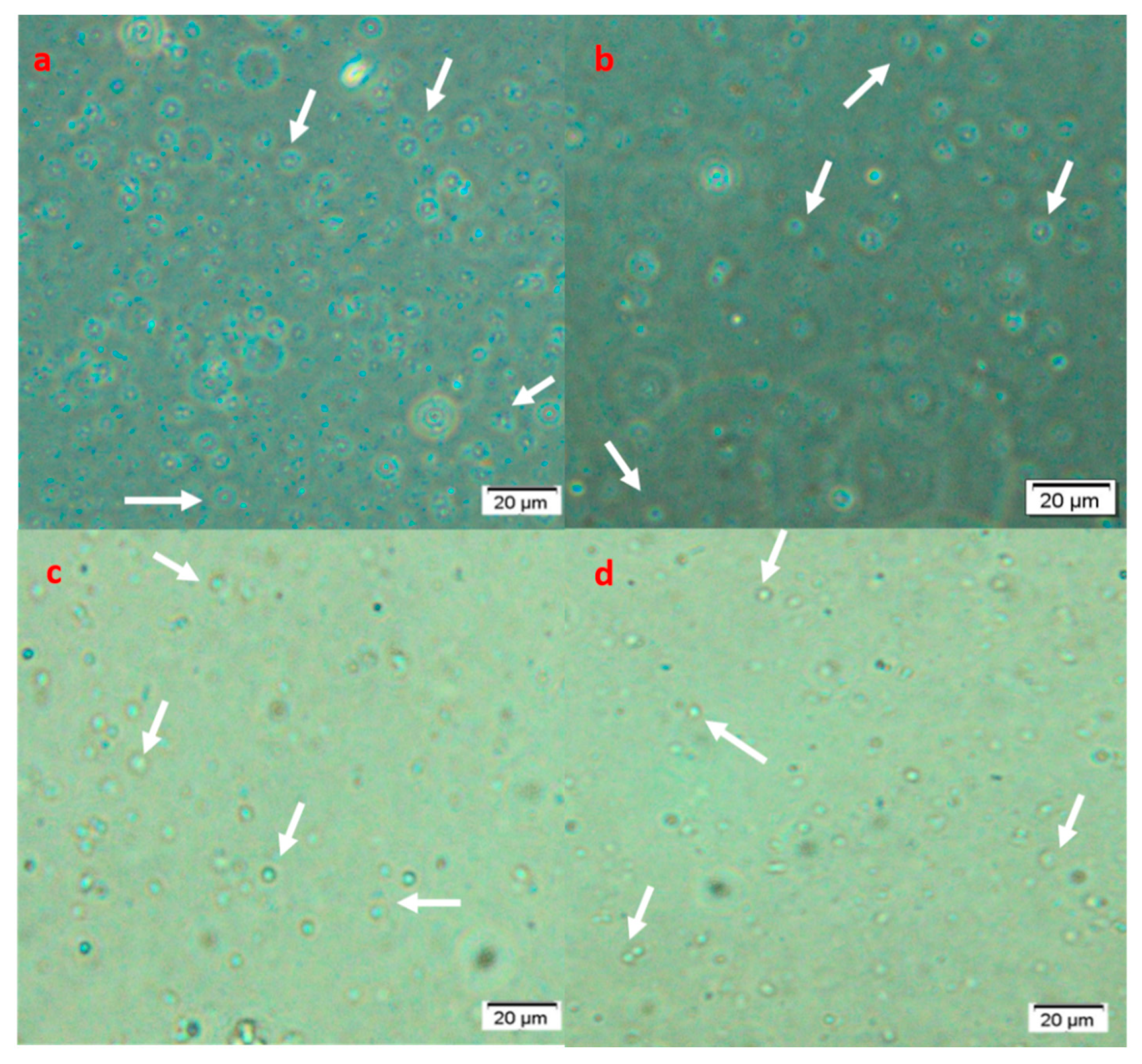
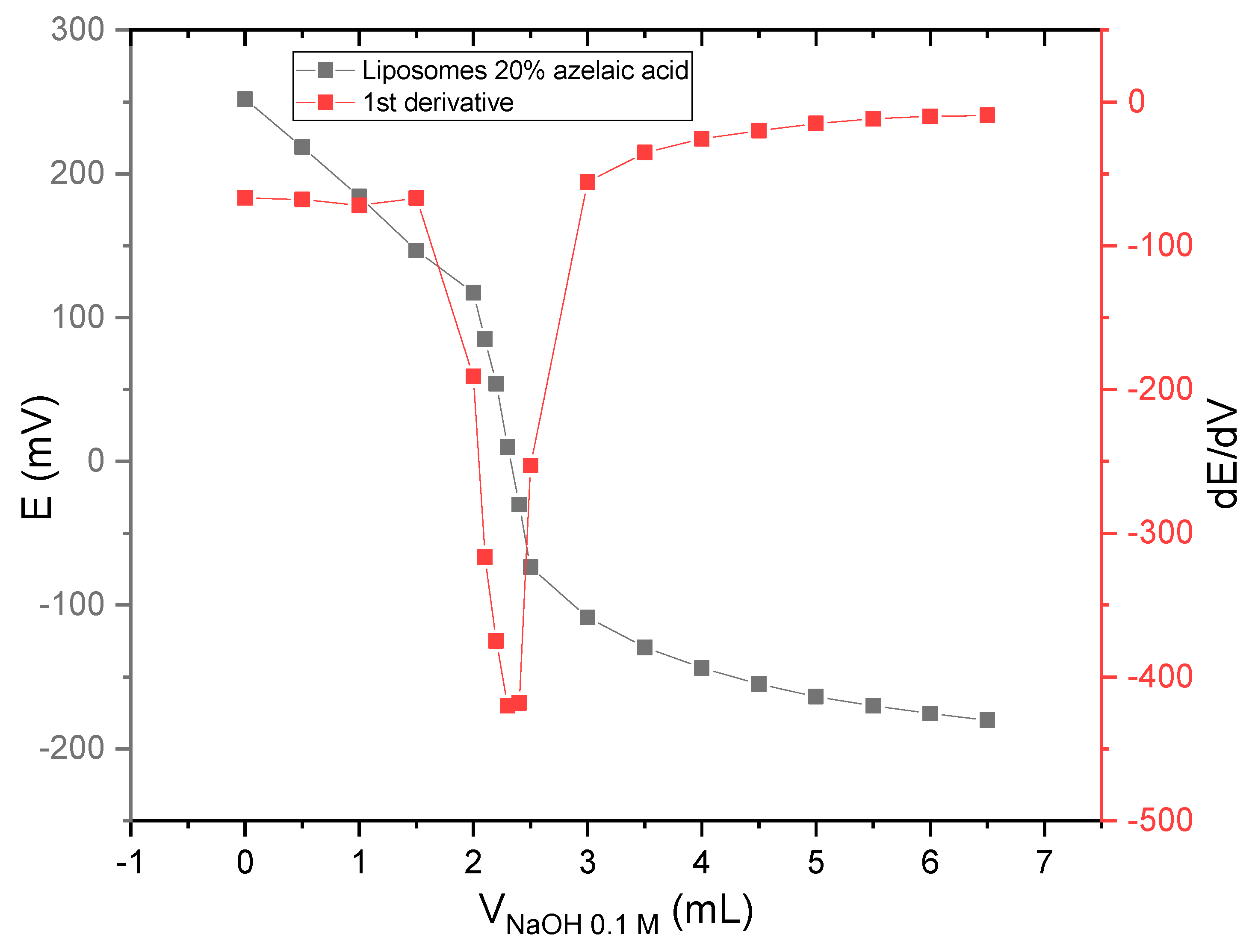
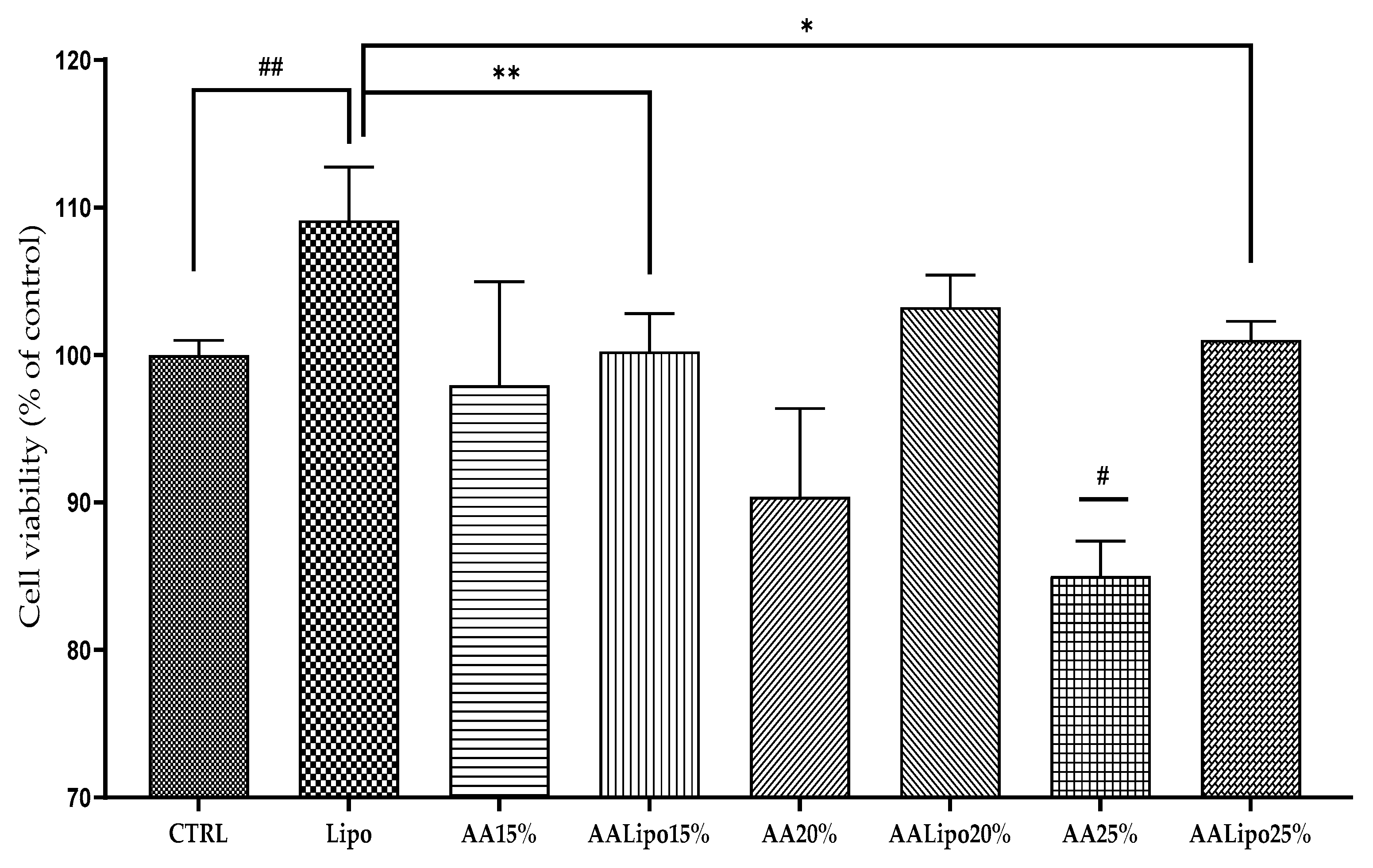

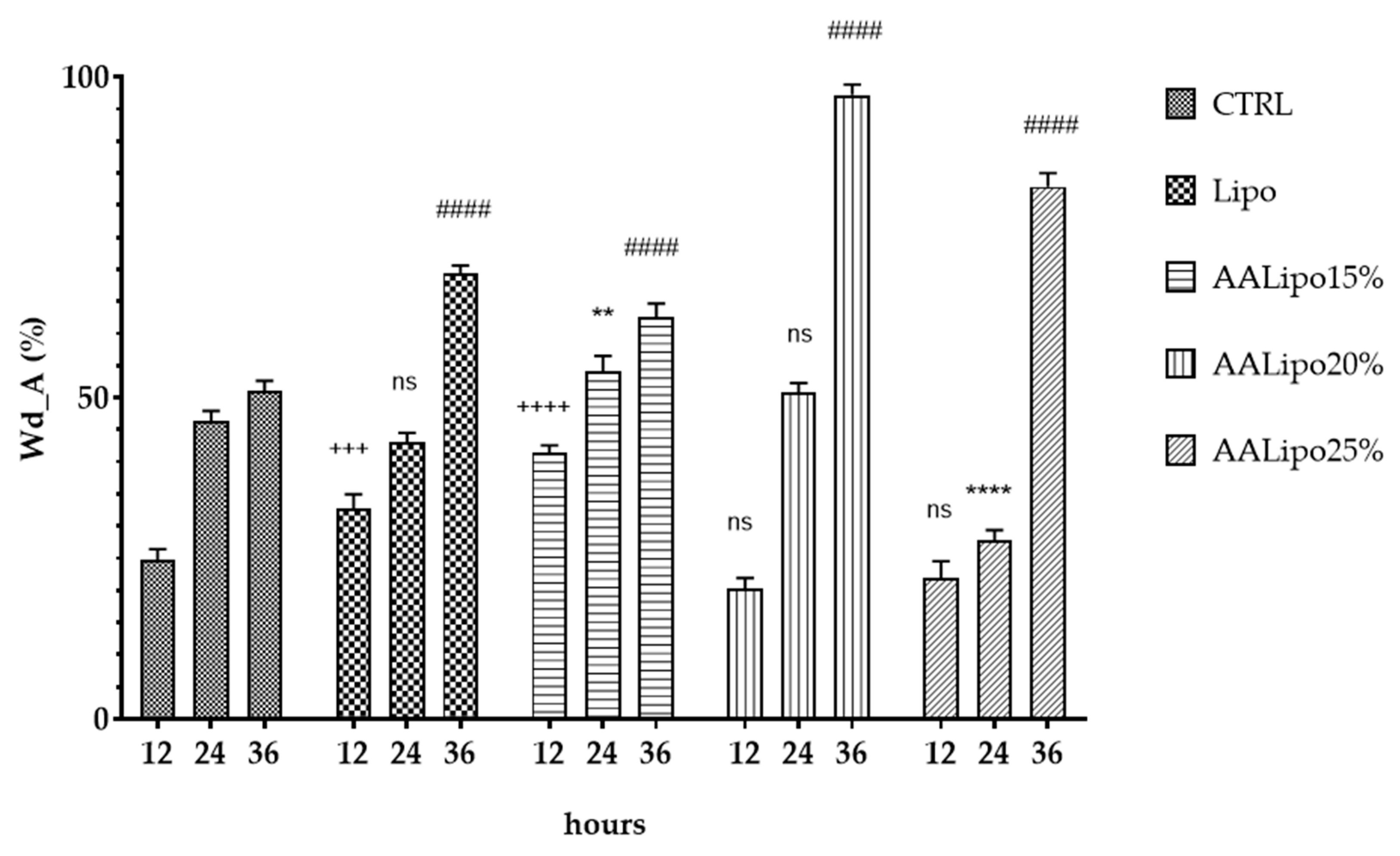

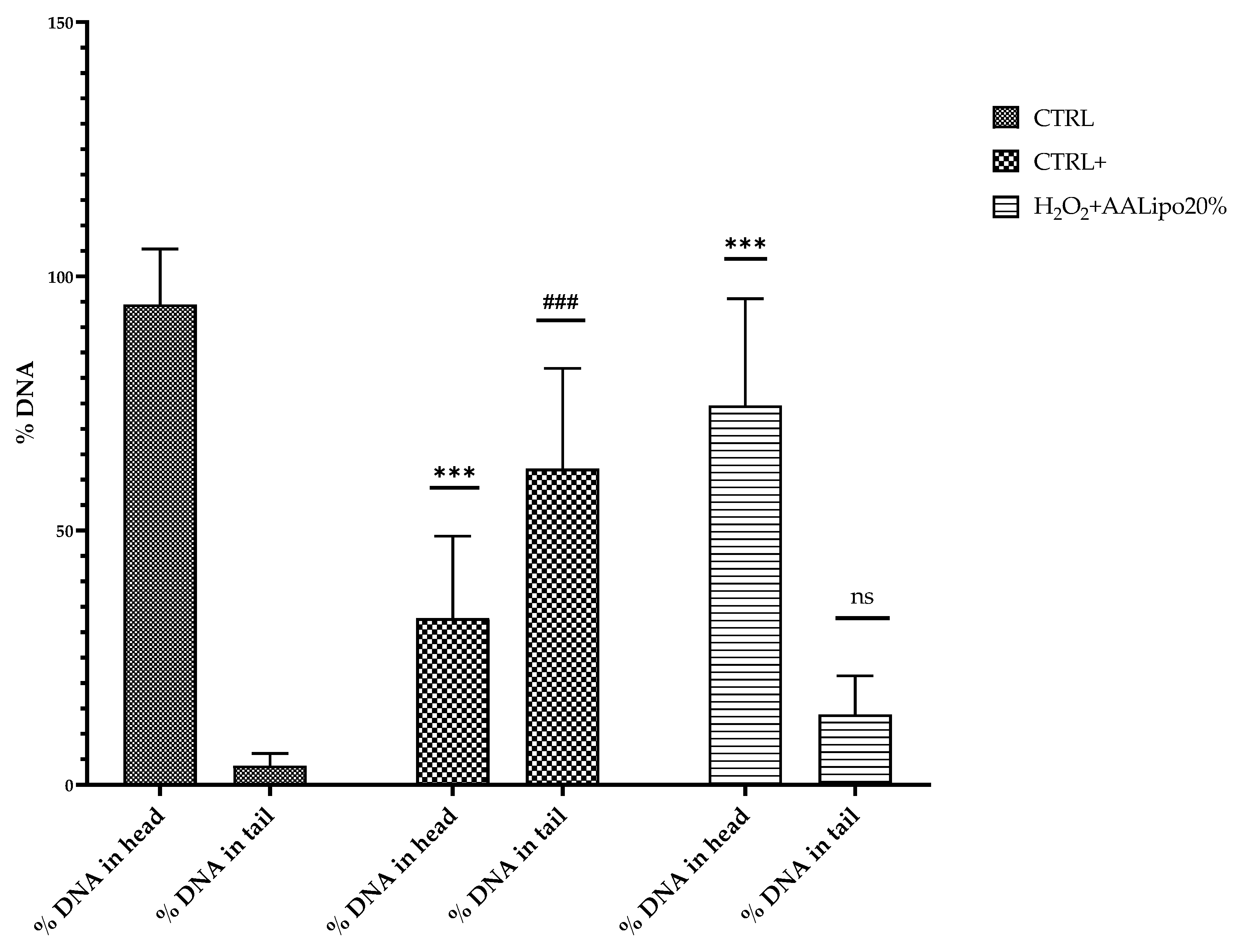
| Formulation | Size Percentage Up to 500 nm | Zeta Potential (mV) | EE% AA |
|---|---|---|---|
| Lipo | 77.39% | −16.6 | 0 a |
| AALipo15% | 85.39% | −17.02 | 77.3 |
| AALipo20% | 85.73% | −19.85 | 85.73 |
| AALipo25% | 77.3% | −20.00 | 79.25 |
| Bacteria | S. aureus | E. fecalis | E. coli | P. aeruginosa | |
|---|---|---|---|---|---|
| Samples | Inhibition Zone ± SD (mm) | ||||
| AA15% | 20 ± 0.12 | 20 ± 0.11 | 13 ± 0.11 | 9 ± 0.30 | |
| AA20% | 23 ± 0.15 | 21 ± 0.15 | 15 ± 0.15 | 10 ± 0.12 | |
| AA25% | 22 ± 0.20 | 20 ± 0.11 | 20 ± 0.12 | 11 ± 0.30 | |
| AALipo15% | 22 ± 0.14 | 22 ± 0.10 | 18 ± 0.20 | 9 ± 0.11 | |
| AALipo20% | 26 ± 0.20 | 24 ± 0.13 | 19 ± 0.14 | 10 ± 0.20 | |
| AALipo25% | 20 ± 0.30 | 20 ± 0.20 | 16 ± 0.12 | 11 ± 0.12 | |
| Van 30 µg | 18 ± 0.40 | - | - | - | |
| Amp 2 µg | - | 0 | - | - | |
| Ctx 30 µg | - | - | 33 ± 0.40 | - | |
| Ctz 30 µg | - | - | - | 24 ± 0.30 | |
| Samples | % Cell Viability |
|---|---|
| CTRL | 93.25 ± 5.21 |
| Lipo | 94.15 ± 3.50 |
| AALipo15% | 93.35 ± 4.90 |
| AALipo20% | 94.11 ± 8.11 |
| AALipo25% | 94.48 ± 5.24 |
Publisher’s Note: MDPI stays neutral with regard to jurisdictional claims in published maps and institutional affiliations. |
© 2022 by the authors. Licensee MDPI, Basel, Switzerland. This article is an open access article distributed under the terms and conditions of the Creative Commons Attribution (CC BY) license (https://creativecommons.org/licenses/by/4.0/).
Share and Cite
Pasca, P.M.; Miere, F.; Antonescu, A.; Fritea, L.; Banica, F.; Vicas, S.I.; Laslo, V.; Zaha, D.C.; Cavalu, S. Novel Liposomal Formulation with Azelaic Acid: Preparation, Characterization, and Evaluation of Biological Properties. Appl. Sci. 2022, 12, 13039. https://doi.org/10.3390/app122413039
Pasca PM, Miere F, Antonescu A, Fritea L, Banica F, Vicas SI, Laslo V, Zaha DC, Cavalu S. Novel Liposomal Formulation with Azelaic Acid: Preparation, Characterization, and Evaluation of Biological Properties. Applied Sciences. 2022; 12(24):13039. https://doi.org/10.3390/app122413039
Chicago/Turabian StylePasca, Paula Melania, Florina Miere (Groza), Angela Antonescu, Luminita Fritea, Florin Banica, Simona Ioana Vicas, Vasile Laslo, Dana Carmen Zaha, and Simona Cavalu. 2022. "Novel Liposomal Formulation with Azelaic Acid: Preparation, Characterization, and Evaluation of Biological Properties" Applied Sciences 12, no. 24: 13039. https://doi.org/10.3390/app122413039
APA StylePasca, P. M., Miere, F., Antonescu, A., Fritea, L., Banica, F., Vicas, S. I., Laslo, V., Zaha, D. C., & Cavalu, S. (2022). Novel Liposomal Formulation with Azelaic Acid: Preparation, Characterization, and Evaluation of Biological Properties. Applied Sciences, 12(24), 13039. https://doi.org/10.3390/app122413039


_Cherfan.png)







